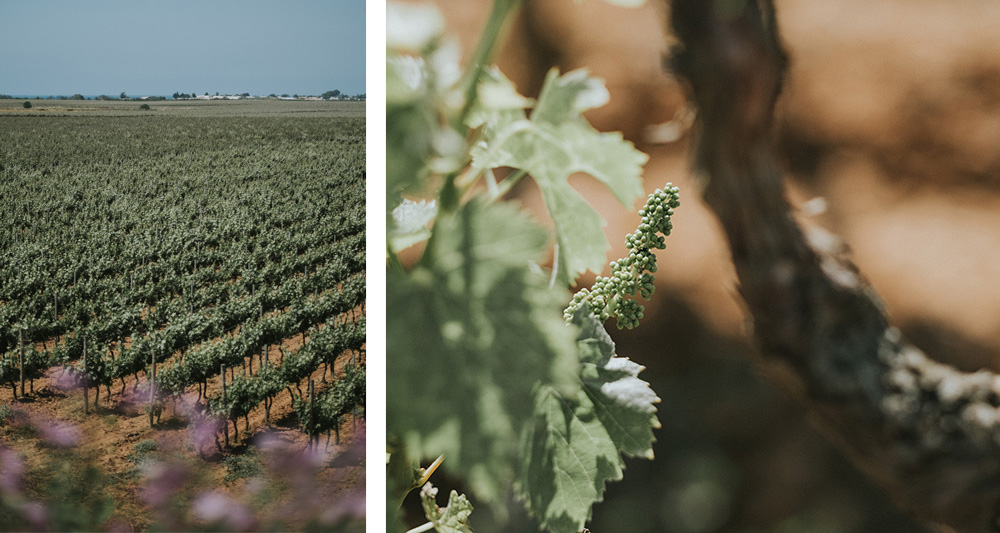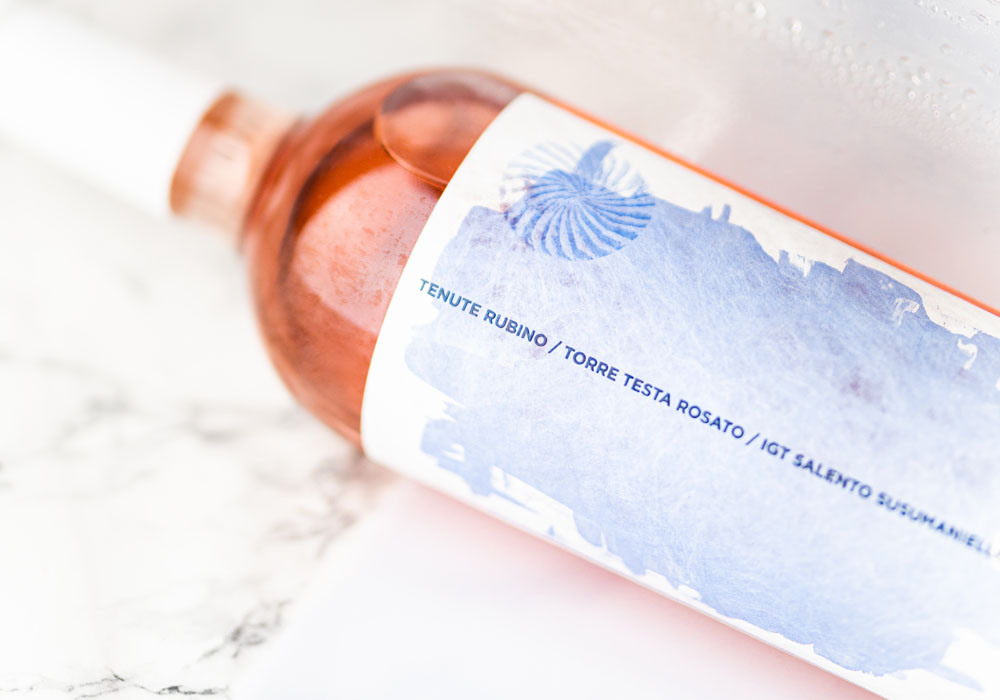-
Jaddico Estate
-
Uggìo-Punta Aquila Estate
-
The Ostuni vineyard
-
Palombara Estate
-
Padula di Geremia Estate
-
Torre Testa
-
Visellio
-
V’itra
-
Jaddico
-
Palombara
-
Oltremé
-
Miraglio
-
Punta Aquila
-
Lamo
-
Sumaré 27 months
-
Sumaré 60 months
-
Salende
-
Libens
-
Lamiro
-
Giancòla
-
Saturnino
-
Oltremé Rosato
-
Torre Testa Rosato
-
Aleatico
-
Aspettando San Martino
-
Cantine Aperte
-
La Vendemmia delle donne
-
RAP
-
Rubino Wine Party
-
Saturnino Wine Party
-
Tenute Rubino Wine & Friends
The vine
Susumaniello can be considered the soul of Salento as this is where the black grape variety has found its ideal home. Its native origins can possibly be traced back to ancient Dalmatia, but experts have yet to come up with a definitive answer. What we know for sure is how unique this exceptional grape is, both in its character and origin of name.
Also known as Somarello, Zuzomaniello, Cozzomaniello, Susumaniello is renowned for the very generous yields produced by this vine in the early years, an abundance of clusters which weigh down the plant like a donkey (‘somarello’ literally means ‘small donkey’ in Italian). Despite its notorious hardiness and resistance to pathogens, for many years Susumaniello was on the verge of falling into oblivion, until Tenute Rubino recovered it, enhancing its versatility and making it the emblem of its production philosophy.
With every harvest Susumaniello’s bountiful yields tend to decrease significantly coming down to just below 1 kg per plant on average. It is precisely when Susumaniello’s yields decline, however, that the vine reveals all its extraordinary qualities, giving life to black-bluish grapes from which wines of great structure and highly concentrated aromas can be obtained.

The Recovery Project
The popularity of Susumaniello declined sharply in the early 90s, as many Apulian growers were driven to explant their less productive vineyards. Luigi Rubino, a long-time connoisseur of this grape’s unique qualities, chose to stake his company’s fortunes on the rediscovery and promotion of one of Puglia’s most identitarian varieties. It is grown in the estate of Jaddico, on the shores of the Adriatic Sea, 8 kilometres north of Brindisi, in a 20-hectare single vineyard.
The vines benefit from the influence of northerly winds and are protected from the drying effects of the sirocco. During the grapes’ latest ripening stages, the diurnal temperature ranges increase, promoting the accumulation of polyphenols and higher concentrations of aromatic compounds.
Trained either as espalier or as bush vines, the plants grow on calcareous soils rich in sand which allow for a luxuriant development of the root system and ensure that excess water is effectively drained. Obtained from the massal selection of a 75-year-old vineyard, the number of Susumaniello plantings was increased in the early 2000s. The vineyards are constantly monitored according to a rigorous production protocol aimed at maximising the grapes’ extraordinary qualitative impact.
Ampelographic description
Bud burst:
At bud burst the bud has an expanded—its bristly, green apex shines with coppery margins. The apical and basal leaflets, velvety and light green in colour, are cupped and the bud’s axis has a curved shape.
Shoots:
The shoots don’t have lenticels and are characterised by a circular cross section, a smooth and partially bristly outline and their green colour.
Tendrils:
The tendrils are of average length and width, they are green in colour with a bifid structure.
Inflorescence:
The inflorescences are average size with an elongated simple or compound form.
Flower:
The flower is a hermaphrodite with a medium sized, globular shaped flower bud.
Leaf:
The leaf is medium size with a five-lobed, pentagonal shape. The petiolar sinus has a U shape while the sides form a closed lyre. The leaf is characterised by a green, smooth and glossy upper blade, and a lighter green lower blade and a serrated margin. The superior and inferior veins are protruding, light green in colour and bristly.
The margin is thin and flat with a smooth surface. The lobes are flat and the angles at the top are pointed. The petiole is light green in colour with pink hues, it is average size, short and smooth and has a cross section with an indistinct canal.
Grape cluster:
The Susumaniello grape cluster is medium size with a compact appearance and a simple, often compound, elongated, pyramid shape.
It is 18-19 cm in length, the peduncle is visible and woody up until the first branches and the rachis is pale green.
Grape:
The grape berry is medium size (14-15 mm), spherical and regular.
The style remnant is present, slightly sunken and has a regular, circular cross section.
The skin is highly pigmented and priunose, blue in colour with an inconsistent medium thickness and a homogeneous colour.
The pulp is soft and colourless with an unrefined, neutral taste and its juice has little colour. The pedicel is short and green and the separation between the berry and the pedicel is difficult.
Grape seeds:
On average there are two grape seeds to every berry, they are large, pear-shaped with a short and large beak.
Cane:
The cane is long, robust and flexible with few branches, it has resistant bark with an elliptical cross section, a striated, non priunose, smooth surface with flattened knots. The length of the internodes is 8-9 cm, and they are a uniform, light hazelnut colour; the buds are conical; the base of the petioles are curved and protruding with a flat, curved diaphragm and fairly abundant tissue.
The buds are protruding and the wood is difficult to cut.
Trunk:
The vine’s trunk is robust with a knotted stump.
Phenology
Vegetative phenomena
Germination occurs in the first ten days of April, giving time for flowering between the 23rd of May and the 7th of June.
The growth of the shoots usually stops between the end of August and the beginning of September, with the grapes ripening between the 7th and the 12th of September. This explains why Susumaniello is harvested in the second half of September.
The leaves start to fall in the first fifteen days of November.
Growing season characteristics and capabilities
Vigour:
The vine vigour in its youth is very high, tending to decrease from the year 10-15.
Production:
The young vine has an abundant production (70 q/ha). Once the vine is over 10 years old, production falls to 50 q/ha with a progressively decreasing yield as the vine ages.
Position of the first fruit-bearing buds: 2nd and 3rd node.
Average number of inflorescence per bud: 2
Female fertility: none
Performance using multiplication by grafting: Defective
Affinity with American rootstocks: good in the initial phase but is consumed immediately.
Organoleptic properties
Susamaniello’s skin contains high levels of anthocyanins, giving it an intense, dark colour.
Susumaniello produces wines with a good alcoholic structure and with a remarkable texture.
On the nose Susumaniello gives characteristic aromas of red fruits, particularly of plums, you can also perceive herbaceous notes with a final hint of spice.
On the palate Susumaniello wines are characterised by their complexity and structure, with a discrete acidity and an elegant tannin which lends itself well to a long maturation.
In general Susumaniello wines are complex and enduring, with a long finish and a well-defined texture which uniquely distinguishes its character.

Alberello – protecting the Apulian bush-vine
Since ancient times, the bush vine has been identified as the best system to overcome a number of problems such as droughty soils, excess wind exposure and scarce rainfall. Not too long ago, the vineyards of Puglia—and Salento in particular—were mostly planted as Alberello bush vines.
This ancient training system has played a key role in the local agricultural development, characterised by a dry climate and poor soils (as in the case of those we find in the area Brindisi and down towards Santa Maria di Leuca) allowing growers to obtain small yields of high quality grapes despite the lack of water. The bush vine enabled the cultivation of the region’s noblest red-skinned grapes such as Primitivo, Negroamaro and Susumaniello. Balancing the interaction between dry soils and a harsh climate, this system allows for optimal arrangement of the grape clusters on the plant, good sun exposure and protection from excess heat. At night-time, the closeness to the ground of the fruit-bearing stems keeps the grapes warm as they ripen. This is an ancient viticultural practice, and yet so modern, preserved by Tenute Rubino with pride and dedication.
Tenute Rubino has always adhered to a philosophy of recovery, protection and enhancement of Puglia’s wine heritage. The company’s focus on the Apulian bush vine embodies a capital of agricultural know-how and cultural heritage that deserves to be preserved. It is from traditions such as these that the identity of an entire farming community lives on, but also the secret recipe behind a wine of inimitable quality. In the vineyards of Tenute Rubino, the ancient art of bush-vine training comes to life just as it did thousands of years ago.
The company’s total area under alberello vine is divided among the family’s estates and comes up to about 90 hectares in total, all dedicated to the farming of native varieties such as Negroamaro, Primitivo and Susumaniello. The oldest plantings date back to the decades between 1914 and 1984: a real window onto the age-old traditions of Mediterranean agriculture. The vines grow to be no higher than one meter, standing one and a half meters apart and first established in pots – a farming practice which, thanks to its complexity and the typical hot-arid climate of the Mediterranean basin, is able to give life to grapes of high quality and wines of unparalleled structure.

The wines
The harvest time of Susumaniello grapes varies depending upon the wine. Our flagship wine is Torre Testa—a cru made with grapes harvested in late September. This particular wine is a true emblem of its territory: the perfect synthesis of complexity and elegance.
Oltremé, on the other hand, is obtained from grapes harvested in mid-September. Exuberant and fresh, approachable and seductive on the palate, this is a wine rich in fruity aromas, pleasant and elegant. The grapes selected for the vinification of Sumaré, Tenute Rubino’s first classic method sparkling single-vintage, are harvested ahead of their normal ripening time to ensure adequate acidity for the required in-bottle second fermentation. This dosage brut sparkling wine rests on ambient yeasts for over 30 months and its success has led to the creation of Sumaré BrutNature, a vintage dosage-zero sparkling wine ready for disgorgement after resting 42 months on ambient yeasts, and Sumaré Brut60. Finally, the family of Tenute Rubino’s Susumaniello labels is completed by Torre Testa Rosè obtained from grapes harvested within the first ten days of September: freshness, flavour and persistence with a bold Mediterranean personality.


